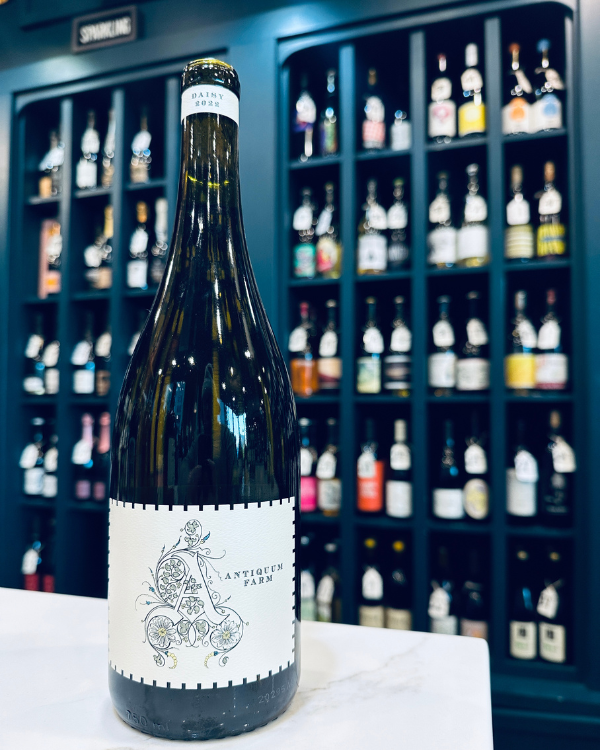Winemaker Spotlight
Want to rub a wine pro the wrong way? Tell them you don’t drink white wine in the winter. We drink rosé, bubbles, and our favorite white wines all year long because when it comes to wine, there are no rules. The only thing that matters is the mood you’re in and the food in front of you. A buttery, piping hot grilled cheese filled with Gruyère alongside a luxurious Verdelho? That’s what we want.
This month I’m showing off three wines that come from staunch vignerons committed not only to sustainable, but environment improving, growing practices. They embody the spirit we look for in winemakers when searching for new bottles for our shelves. Join along as we drink our way through Oregon, Sicily, and of course, California.
Antiquum Farm, Daisy Pinot Gris
Grazing-Based Viticulture was first conceived and implemented at Antiquum Farm. The central tenet of this process is to grow wines that clearly communicate the wild and honest soul of their land and the principles of its people. Antiquum Farm is managed without fertilizers, compost, or foliar feeds in order to truly isolate their site, conserve resources, and create wines of individualistic spirit and truthful terroir. They see their farm as a complex community where the vines are part of a whole, not the whole.
Through this paradigmatic shift in philosophy, they seek new answers to an age-old question: What endows a particular site with its personality, its soul, its terroir? Conventional viticultural theory tells us it’s the topographical orientation of the slope combined with the elemental and structural composition of the soil. Then again, aren't there many vineyards all over the world with similar or even identical slope angles, aspects, and soil types as their neighbors?
At Antiquum Farm, they believe commonly held conceptions barely scratch the surface of terroir while disregarding two of its most important determinants: the microbiological community in the soil and the relationship between that community and the vines living in that soil.
Soil is a living system. They believe that a vibrant, emphatically alive place is the defining foundation of terroir. They have grown to understand that most practices accepted as sustainable are actually quite destructive to the life of the soil and to the character of the vineyard. -Antiquum Farm
At first sip, Daisy is a rush of mouthwatering salinity and juicy Bosc pears. The wine is soft and clear with never-ending layers of flavor. It opens up with such elegance, it’s one of the most memorable wines I’ve tried. This is not your daughter’s basic Pinot Grigio. Daisy is what you pour for your chic, elusive aunt who only visits once a year. Roast yourself a chicken with lots of thyme for this one.
Forlorn Hope, Verhelho RHV
Matthew Rorick has been the winemaker behind the Forlorn Hope wines since the inception of the label in 2005, and tends 75 acres of organically farmed grapevines at Rorick Heritage Vineyard. In previous incarnations he has repaired submarine telescopes for the United States Navy, ridden skateboards for a living, and built electric guitars. His love of wine was fostered in him by his grandfather David Rorick Jr., who was a consummate dining partner and storyteller. His current efforts at RHV, including producing organically farmed estate wines and reconnecting with California’s pre-Prohibition viticultural traditions, are largely inspired by conversations at his grandfather’s table.
The Forlorn Hope estate wines are honest and pure representations of site and variety. They believe deeply in the magic of organic viticulture and the beauty of Calaveras Limestone. Producing wines that embody the uniqueness of their estate requires that they don't alter what the vineyard bears, and to this end, they do not adjust the chemistry of the grapes with additives, commercial yeast, or bacteria. All of their wines are spontaneously fermented by native yeast that exist naturally on the grapes. In this way, whether the wine in question is complex and nuanced or bright, cheerful, and easy-drinking, it will be a true and unadulterated expression of the Rorick Heritage Vineyard.
Verdelho is among the noblest of the wines produced at Forlorn Hope. With Matthew’s experience of working with it for more than a decade from Napa Valley, across Lodi, and in the Sierra Foothills, he has long believed that this variety is exceptionally well suited to California’s climate. Even so, he was entirely unprepared for how much our Verdelho enjoys being grown on the limestone of Rorick Heritage Vineyard. With a balanced interplay between bright acidity, depth of flavor, and textural richness, this wine is a beautiful expression of the heights that Verdelho can attain in our state and will age extremely well.
This deeply nuanced wine has complicated layers. An intellectual wine that also gives pleasure and deepens in interest if you allow it to unfold in your glass or decanter. It doesn't shout for your attention; its alluring whispered aromatics draw you in. Texture and tension builds, and unexpected flavors emerge. Baking spices and sappy fruit; green peach laced with vanilla bean; the beginning of a pleasant, gentle reduction; wet slate and orange creamsicle. The finish puts salivary glands to the test and you can’t help but take another sip. -Forlorn Hope
Tenuta di Aglaea, Linophyrne Aglaea
Aglaea – the youngest of the Three Graces or three sisters, and daughters of the God Zeus. Aglaea was the goddess of beauty, splendor, glory, magnificence and adornment. At times she acted as messenger for Aphrodite, the goddess of love.
Aglaea represents Anne-Louise Mikkelsen’s sentiments for Etna; with what her wines try to express, and how they do so. In that sense the wines of Tenuta di Aglaea act as her messengers from Etna.
This Nerello Mascalese is a result of unique terroir that makes the vineyards – a direct consequence of Etna and its numerous eruptions since its volcanic activity began more than half a million years ago. The lava flows hardened layers upon layers, and ashes filled on top. The result today is a very porous soil that is abundant in minerals, and extremely fertile. The vineyards are cultivated in terraces held up and apart by ancient stone walls 3-4 feet high.
Their vineyards are located at the north side of Etna 2300-2700 feet above sea level providing for a relatively cool climate but with lots of sunshine, and light not least from the reflections coming of the sea, and the surrounding mountains with their characteristically high proportion of chalk. All the vineyards are planted with Nerello Mascalese.
This wine grabs your attention with savory acidity but keeps you thinking with its incredibly long, textured finish. With each sip you’re transported to a dry, brushy hillside under the hot Sicilian sun. Anyone who normally reaches for Sangiovese or Nebbiolo needs to turn their attention to Nerello Mascalese.



